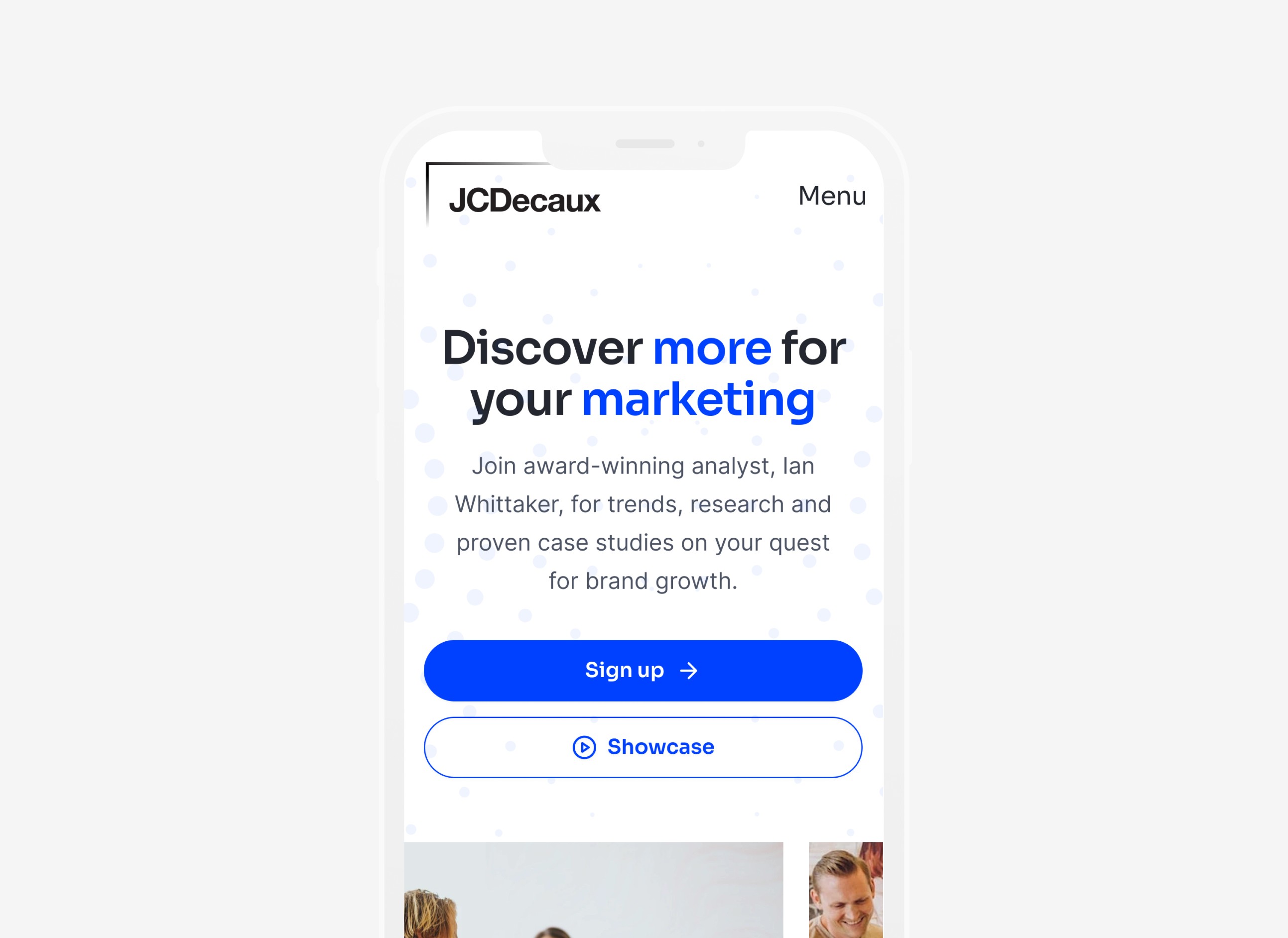JCDecaux
Boosting loyalty and returning users to JCDecaux's UK microsite for senior marketers and industry thought leaders.
Product Design
*
Personalisation
* 01 / Project Overview
JCDecaux's UK microsite comes to life to offer senior marketers and industry thought leaders share their top tips for better marketing results. Marketing trends, award-winning research and case studies at your fingertips. Have they done a good job building community so far?
my role
Responsible for research, conceptualisation and design (concept project at proposal stage).
the team
1 designer, 1 product manager, and 2 engineers.
timeline
2 weeks
The impact
The microsite's concept redesign successfully addressed key pain points, providing a user-friendly, accessible, and engaging platform for senior marketers and industry thought leaders. The project highlights the importance of a user-centered approach in digital design, resulting in enhanced content discovery and a clearer value proposition.
* 02 / Problem statement
JCDecaux delivers high-quality content curated by experts but struggles with making this content easy to discover, resulting in a lack of a rich, engaging user experience. Users have no incentive to return due to the absence of acquisition and loyalty stages in the web experience. Additionally, the homepage fails to clearly communicate the site’s value proposition, leaving visitors unsure of the USP.
Breaking down the problem
1
Content is key (and king) 👑
JCDecaux offers excellent content curated by industry experts, yet this content is hard to find, limiting user engagement.
2
Hooked? 🎯
The site lacks features or patterns to encourage user return, and no previous knowledge or planning of the acquisition and loyalty stages of the user journey was clear to us.
3
Should I stay or should I go? 🎶
The homepage does not clearly communicate the site’s value, leaving users unsure of its benefits. The 15 second rule, broken.
4
On the go? 🤳
Poor responsive design affects mobile traffic, crucial for senior marketers who often access the site on the go.
* 03 / Process
We kicked off the process with a comprehensive round of stakeholder interviews to quickly become experts in their industry and understand what success would look like for the business.
To understand the existing user experience, we talked to internal stakeholders, did a UX audit of the existing website, conducted user interviews, and completed competitor research.
With all the research completed, as a team we began with an in-depth analysis of the existing microsite, identifying key pain points through user feedback and usability testing. Competitor analysis provided insights into industry best practices.
With the flows built, we gathered feedback from existing customers & experts, aiming to optimise the design. We finally developed user personas based on senior marketers and industry thought leaders to guide design decisions and ensure the site meets their needs.
The users
We conducted user interviews with potential and undecided users (sourced via CS). Our main goal from the interviews was to understand their needs, pain points and spot any new opportunities.
Design goals
key takeaways
We must enhance UX
Introducing a logical site structure with intuitive navigation, ensuring users can easily find and explore content is a must.
Lack of clear value proposition
Time spent on task (measured during our testing phase and historically from GA) was unsatisfactorily high, users weren't clear on the basics, or the process.
Intuitive
Simplify navigation and improve user journey to ensure visitors can easily find and engage with high-quality content.
Engaging
Create a compelling value proposition and implement features that encourage return visits, such as personalized content and loyalty programs.
Community-Focused
Foster a sense of community by encouraging interaction, discussion, and sharing among users, providing a platform for ongoing engagement and collaboration.
* 04 / Solution
Final outcome
Each highlight captures an aspect of the new user experience. It calls out which design goal it adheres to, what user scenario or problem its solving and what the solution is.

A landing page with conversion in mind
USER SCENARIO
The old design didn't featured a single CTA leaving users out of the conversion equation
SOLUTION
Incentivating registration and putting the content at the front were both our most recurrent petitions during research
Is this for me?
USER SCENARIO
Before, users didn't have any ways of filtering content or assessing relevance. For such a busy, picky and expert audience this is enough reason to abandon the site on a first browse.
SOLUTION
Personalisation must play a fundamental role as part of a new content strategy and UX overall. We want to ease content discovery and relevance for seamless interaction.
Most common (and wanted) actions, above the fold
USER SCENARIO
Before, users relied on the main navigation or lenghty scrolls in order to perform what we identified as the most wanted & common actions, search & sign up/ log in.
SOLUTION
Giving users what they want, making it accessible and in fewer clicks were at the top of our priorities list.
Clear value proposition, no fluff
USER SCENARIO
The old design presented a very text heavy layout with lenghty explanations, often with too much jargon - even for a technical audience.
SOLUTION
A more clean, minimalist UI opens the door for a new content strategy. Copywritting plays a crucial role in convincing, but first of all, in informing and clarifying.
* 05/ Learnings
Taking notes for the future.
How do Out-of-Home and Social Media work together? There is a growing interplay between public screens such as Out-of-Home and private screens such as smartphones. The JCDecaux Two Screen Future research demonstrates how you can make your private channels work harder by using public channels to prime the other channels in your media mix, increasing attention and dwell time on your ads. Watch this video to find out more and get in touch for the full research.
Want to know more?
Book an interview with me to get extended
insights and answer all your questions.















